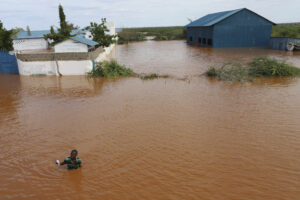Kenya Floods Displace 7,000 as Lake Levels Surge

Kenya Floods Displace 7,000 as Lake Levels Surge
Severe flooding around Kenya’s Lake Naivasha has forced thousands of families from their homes, with communities describing this year’s disaster as the worst they have ever seen. Boats that usually carry tourists across the popular Rift Valley lake are now being used to rescue stranded residents from submerged neighborhoods.
In Kihoto, one of the hardest-hit areas, floodwaters have pushed nearly 1.5 kilometers inland a distance local authorities say has never been recorded before. Homes, churches, and even police stations are underwater, leaving residents stunned and desperate.
“We have never witnessed flooding on this scale,” said Rose Alero, a resident whose home now has waist-deep water. She described overflowing toilets, rising sickness, and families with nowhere to go. “People are suffering,” she added.
The sudden rise in water levels has forced children to flee schools on makeshift rafts, while entire villages have watched their belongings wash away. According to Joyce Cheche, Nakuru County’s head of disaster risk management, more than 7,000 people have been displaced. Wildlife habitats have also been affected, raising concerns for tourists and workers in the area.
ALSO READ: Alabama Pastor Reaches Nonbelievers Through Chaplaincy
The county government has organized evacuations and introduced health precautions, but many families say they have received no financial support. Fear of cholera outbreaks and possible landslides has kept many flower farm workers — a key local workforce from returning to their jobs. Residents also face the added threat of hippos, which are increasingly coming in contact with flooded communities.
“We didn’t anticipate anything like this,” Cheche said.
On the lake’s edge, skeletal acacia trunks mark areas once covered by forest but are now swallowed by advancing water, which continues to spread by nearly a metre each day.
Experts say the situation is part of a wider pattern affecting several Rift Valley lakes. While many scientific studies highlight unusually heavy rainfall linked to climate change, geologist John Lagat argues that tectonic activity beneath the lakes plays a major role. He explained that shifting geological plates have gradually blocked natural underground outlets, trapping more water in the basin. Still, he noted that rising rainfall and land degradation due to population growth are worsening the impact.
Back in her flooded home, Alero fears what the next rainy season might bring. “We are very worried,” she said. “Nobody can tell what will happen next.”
Content Credit: Moyosola Oni
Image Credit: Google .Com




